2020 Harley-Davidson Livewire Review - First Ride

Riding Harley-Davidson's most important motorcycle in 100 years
To evaluate the 2020 Harley-Davidson Livewire, you need to let go of everything you know – and everything you think you know – about Harley-Davidson. The haters will cry this is an answer to a question nobody asked, instinctually sh*tting all over Harley for seemingly alienating its core, internal combustion, customer (just look at our Facebook post for proof).
2020 Harley-Davidson Livewire
| Engine | 19.0/20 |
| Suspension/Handling | 12.0/15 |
| Transmission/Clutch | 10/10 |
| Brakes | 9.5/10 |
| Instruments/Controls | 4.25/5 |
| Ergonomics/Comfort | 8.0/10 |
| Appearance/Quality | 9.0/10 |
| Desirability | 7.0/10 |
| Value | 3.0/10 |
| Overall Score | 81.75/100 |
But the reality is The Motor Company (actually, the motorcycle industry as a whole) is in need of some new blood to replace its aging core of riders. And, whether you like it or not, it’s also no secret that the electrification of transportation and personal mobility are the way of the future. Now, before you get up in arms, know this: Harley-Davidson isn’t turning its back on its traditional internal combustion motorcycles.
But as any good financial advisor would tell you, it’s good to diversify. Which is why, in addition to its line of cruisers and baggers, we’re going to see a large and distinctly different lineup from Harley-Davidson in the coming years, including Adventure bikes, Streetfighters, and yes, electrics.
Now, it’s very unusual for the CEO of a manufacturer – let alone Harley-Davidson – to attend a press introduction for a new model, and yet there Matt Levatich stood in front of us. He took the stage and addressed the assembled crowd of journalists to emphasize how serious he and the company are to creating the next generation of riders globally, to shift mindsets, and to attract current and future riders of all ages. Livewire is the halo product to lead the way forward for a lineup of Harley EVs to come.
So yeah, this bike is pretty important to The Bar-and-Shield Brand.
An All New Motor Company
If you’ve been keeping track of the E-moto space then you’re no doubt familiar with Livewire. The first prototype of the machine was built in 2012, and since then, 33 bikes very similar to it were produced – at great expense to the company – and taken all across the globe in an initiative that amounted to a massive focus group better known as the Project Livewire Experience. Hell, we even got the chance to ride the bike a few years ago.
What you see here is an entirely different motorcycle to Project Livewire, says Chief Engineer Glen Koval, and while it looks very similar, it doesn’t have a single shared part. This familiarity was intentional because, as Koval explained, the design of the bike is critical to Harley-Davidson, and H-D design centers around the motor. At least now, the design brief can be grammatically correct. Look a little closer at old and new Livewires and subtle differences will reveal themselves.
Positioned low and contrasted by its silver color, the liquid-cooled internal permanent magnet motor – codenamed the H-D Revelation Motor – is a focal point for the eye and produces a claimed 105 hp (78 kW) and 86 lb-ft of torque the moment you twist the throttle. Housed above it is the RESS – Renewable Energy Storage System – or battery to you and me. Rated at 13.6 kWh nominal (15.5 kWh max), Harley stands behind it with a warranty of five years with no mileage limit. Even beyond that five-year span, H-D believes the battery will last the life of the motorcycle. Its air-cooled aluminum housing acts as a big heat sink, while the fins serve double-duty for cooling and attempting to recapture that finned aesthetic so familiar on Harley’s V-Twins. It’s rated at 146 city miles, according to the MIC standard, and 95 miles combined city/highway, which is a more realistic number. Of course, anyone with a heavy right hand can make those numbers fall way down.
Interesting thing about the battery: Weighing in at roughly 215 lbs, the RESS is a massive structure placed centrally in the motorcycle. Using it as a load-bearing member of the chassis means it soaks up much of the lateral movement of a traditional frame. Koval and his team took advantage of this and designed the aluminum “frame” (it’s more like a structure) around it to have incredibly thin walls, making it so light you could pick it up with one hand. Look closer and you’ll see there isn’t a single weld on the frame or swingarm. Instead there are a series of bolts. Koval revealed this was the key to making the Livewire platform modular to produce future models. Remove the six bolts securing the head stock, replace it with a different one with altered geometry angles, and you have an entirely new front end. Swapping components can be done throughout the bike, essentially making an erector set motorcycle.
Harley may have a point about motors being central to the company, but to me, my eye is first drawn to the faux fuel tank. In this case, it’s the charge port housing. A modern take on the classic Peanut tank, the filler cap opens to reveal both a J1772 and DC fast charge port. Using the latter, a depleted battery can reach 80% charge in 40 minutes. A full top-off takes an hour. The slowest charging method – the provided Level 1 charger that plugs into your standard household wall outlet and is stored under the seat – will take about 10 hours to replenish a dead battery.
From there, componentry is more familiar. Showa provides the suspension with the SFF-BP fork and Balance Free Rear Cushion-lite shock (both fully adjustable), with Brembo supplying braking power with two 300mm discs and radial-mount, four-pot calipers. Co-branded Michelin Scorcher tires touch the ground in common sizes: 120/70-17 front, 180/55-17 rear.
What you can’t see is the Livewire’s RDRS, or Reflex Defensive Riding System, otherwise known as electronic rider aids, as is becoming more prevalent in motorcycling. Based on a Bosch six-axis IMU (Inertial Measurement Unit) programmed with proprietary Harley-Davidson software, this allows for Cornering ABS, Cornering Enhanced Traction Control, Rear Wheel Lift Mitigation, and a Drag Torque Slip Control System; essentially preventing rear wheel lock from regenerative braking (say, on a wet road or on slick surfaces) – think of it as an electronic version of a slipper clutch.
Livewire comes with a total of seven different ride modes – four preset and three customizable by the user. The four presets are Sport, Road, Rain, and Range. Judging by the names you should be able to tell how each meters power, but what isn’t instantly obvious is the amount of regenerative braking each is set to. Sport, Road, and Range offer amounts that would feel instantly familiar to anyone coming from gas bikes. Rain mode limits regen to help avoid the rear wheel getting loose (because TC doesn’t work off-throttle, remember?).
Finally, there’s H-D Connect. Being a product aimed towards younger, more affluent customers, these same people are also more tech-savvy. With H-D Connect, the subscription-based interface uses cellular connectivity to connect to an app to provide the owner motorcycle status, charging status, notifications, charge station locations, service reminders and updates, and can even notify the owner if someone is tampering with their bike and track it if someone does decide to roll away with it. Livewire’s TFT touchscreen display also has Bluetooth connectivity to sync with your phone and provide turn-by-turn navigation and music/call information directly to the screen.
A Harley That Doesn’t Make A Sound
With all the hype and tech stuff out of the way, what really matters is what the Livewire is like to ride. Portland, Oregon was the chosen locale by Harley for a few reasons: First, according to Harley reps, there’s a high population of EV owners in this area, which leads to the second point: DC fast charging networks are rapidly growing here. And third, our 65(ish)-mile ride would encompass the environments Harley envisions Livewire owners occupying; a slog through the city to get to the twisty roads en route to work.
Hopping on, my initial impression was how narrow the Livewire is. This definitely ain’t your average Harley. The rider triangle sits the rider a little forward, but without a windscreen it’s just enough to cut through the wind at higher speeds without feeling like too much of a sail.
Like all electrics, the intoxicating part of the ride is twisting the throttle. It’s no different with the Livewire; twist your wrist (especially in Sport mode) and hang on for dear life, because this thing will rip your arms off. Acceleration is mindblowing, and if you’re brave enough to look down at the clear and bright TFT gauges, the speedo will skip several numbers on the way to triple digits. Eventually the mind adapts to the thrust, gets used to the silence, and starts to appreciate the ease of twist-and-go motorcycles, which then affords the brain some room to notice other things.
For example, Livewire’s ride quality is somewhat surprising. It felt as though I could feel the tires rolling over the pavement, with each little imperfection transmitting itself through the tires and to the bars in the form of buzz through the bars. Suspension compliance at both ends felt a little harsh, too, even though it appeared as though (at least for the shock) there wasn’t much preload dialed in. Too stiff a spring maybe? Weird, considering most stock spring rates are spec’d for 150-pound small dudes like Yours Truly, but maybe H-D sprung the bike for the (heavier) average American instead. Nonetheless, on smooth pavement the Livewire rewards the rider who flows through the corners. Try to force the 549-pound bike and it’ll protest, mainly by showing a slight tendency to want to stand while trail braking. Bikes this heavy shouldn’t be manhandled anyway.
Initially I was worried the relatively small 300mm rotors wouldn’t be up to the task of slowing this heavy bike down repeatedly. However, in Sport mode (the mode I kept it in exclusively) regen is set to approximately 80%, and after a bit of experimenting, you find you can simply use the regen to scrub speed for a corner without touching the brakes at all. At slow speeds you can even regen all the way to a stop. So, if you end up a little too hot, regen mixed with a small dab at the Brembos should set you right. Of course, if you’re the type who prefers freewheeling, setting the regen to a lower setting will mean more work for the Brembos.
After 65 or so miles entirely in Sport mode, and with me abusing the battery with a heavy right wrist at every opportunity, my Livewire showed 22% battery remaining. Had I ridden like a normal, sane person, I feel fairly confident the rated 95 combined city miles would be attainable.
The Dawn Of A New Era
Of course, treating the Livewire like a sportbike is kinda missing the point. Harley-Davidson would like you to believe Livewire isn’t for an existing “type” of rider. It’s for someone who wants a premium electric motorcycle.
And this is where I see a problem.
In all fairness, the Livewire is a very good electric motorcycle, deserving of the premium status Harley-Davidson has thrust upon it. It checks all the boxes a top-shelf electric should: brutal power, good looks, acceptable range, fast-charging capability, and tech-heavy features. But here’s the thing: At nearly $30,000 ($29,799), it costs basically as much as the Energica Eva, which rings in between $21,656 – $30,443 (However, this high price includes every option Energica has available for it, including luggage, covers, and anodized bolts. Opt for just the performance options and you’re looking at $28,190).
More importantly, it’s significantly more expensive than the Zero SR/F ($18,995 – $23,295), which some would say is the standard-bearer in the category. It has much of the same tech, charging, and performance features, and arguably handles better. Regardless which of the three you like better, the barrier to entry is high, meaning those who can cross it are an incredibly small group.
But what’s worst of all for electric motorcycles (at least as of this writing) is the lack of federal incentives to offset this large initial cost, relegating these machines to the affluent few who consider themselves early adopters and really want an electric motorcycle. To help offset this, all authorized Harley-Davidson Livewire dealers (of which there are approximately 250 globally at press time, 150 in the U.S.) will offer free DC fast charging for two years to all Livewire owners. Further, Harley will provide U.S. Livewire owners with 500 kWh free charging at all Electrify America DCFC stations. That comes out to about 40 charges.
Ultimately you either like the Livewire or you don’t. It doesn’t necessarily do anything wrong, but it doesn’t blow the category away, thus making it hard to justify the cost over the competition. But give Harley credit for finally getting in the game. This could be the jump-start the industry needs.
Discuss this story on our HD Livewire Forum
2020 Harley-Davidson LiveWire
+ Highs
- Brutal acceleration
- Hi-Tech
- Finally, a major OEM has committed to the electric market
– Sighs
- Pricey
- Heavy
- Ride quality surprisingly harsh
In Gear

Helmet: HJC RPHA 90 Tanisk – $450-$455
- Jacket: Alpinestars Tailwind Air WP Jacket For Tech Air Street – $400
- Airbag: Alpinestars Tech Air Street Vest – $1150
- Gloves: Alpinestars SP-2 v2 – $140
- Pants: Alpinestars Crank Riding Jeans – $250
Boots: Alpinestars SP-1 Shoes – $170
2020 Harley-Davidson LiveWire Specifications | |
|---|---|
| Motor Type | Revelation Internal Permanent Magnet Synchronous Motor with Water Jacket cooling |
| Inverter type | IGBT |
| Pole Count | 6 |
| Power | 105 hp (claimed) |
| Torque | 86 lb-ft. (claimed) |
| RPM max | 15,000 rpm |
| Primary Drive | Spiral bevel gear , 55/17 ratio |
| Transmission | Single Speed |
| Battery Type | Lithium Ion |
| Capacity | 15.5kWh total, 13.6kWh min usable |
| Charge Plug Type | SAE J1772 Combo Inlet (CCS1)/IEC 62196 Combo Inlet (CCS2) |
| On-board charger, charge rate | 1400 W |
| AC wall charging time (not verified) | Target – Full charge in 12.5 hrs – Capable of 12.6 miles/hour charge rate (MIC city cycle) |
| DC fast charging time (not verified) | Target – Full charge in 1.0 hr – Capable of 192 miles/hour charge rate (MIC city cycle) |
| DC to DC conversion | 450W at 14.2V |
| Range (City) | 146 mi (235 km) |
| Range (Highway, 70 mph sustained) | 70 mi (113 km) |
| Range (Combined) | 95 mi (152 km) |
| Range (World Motorcycle Test Cycle) | 98 mi (158 km) |
| Frame | Aluminum cast |
| Swingarm | Aluminum cast |
| Front Fork | Showa 43 mm Inverted Separate Function Forks – Big Piston (SFF-BP), fully adjustable, 4.5 inches of travel |
| Rear Shocks | Showa Balance Free Rear Cushion Lite (BFRC-lite), fully adjustable, 4.5 inches of travel |
| Front Wheels | Black, Split 5-Spoke Cast Aluminum, 17 inches diameter/3.5 inches width |
| Rear Wheels | Black, Split 5-Spoke Cast Aluminum 17 inches diameter/5.5 inches width |
| Front Brakes | Dual 4-piston monoblock radial mount front, 300 mm dual floating rotors; ABS |
| Rear Brakes | Dual-piston caliper, 260 mm floating rotor; ABS |
| Lean Angle | 45° right/45° left |
| Front Tire | Michelin Scorcher “Sport” 120/70 ZR17 58W |
| Rear Tire | Michelin Scorcher “Sport” 180/55 ZR17 73W |
| Length | 84.1 inches (2,135 mm) |
| Overall Width | 32.7 inches (830 mm) |
| Overall Height | 42.5 inches (1,080 mm) |
| Seat Height, Laden/Unladen | 30 inches (761 mm)/30.7 inches (780 mm) |
| Ground Clearance | 5.1 inches (130 mm) |
| Rake (steering head) | 24.5 deg |
| Trail | 4.3 inches (108 mm) |
| Wheelbase | 58.7 inches (1,490 mm) |
| Weight, As Shipped | 549 lb. (Claimed) |
| Weight, In Running Order | 549 lb. (Claimed) |
| Battery | Lithium Ion, 12.8V , 24 Wh, 120 A |
| Charging | Onboard DC to DC conversion |
| Lights (as per country regulation), Headlamp | All LED, low beam, high beam and signature position lamp |
| Lights (as per country regulation), Tail/Stop | LED with light pipe tail |
| Lights (as per country regulation), Front Signal Lights | LED |
| Lights (as per country regulation), Indicator Lamps | High beam, turn signals, ABS, traction control, EV fault |
| Lights, Rear Turn Signals | LED, Amber |
| Gauges | 4.3” WQVGA 480×272 TFT Color Display with Ambient Light Sensor, 9 warning lights, Real Time Clock and Integrated Bluetooth Connectivity to a Smartphone to provide infotainment features including turn-by-turn navigation, telephone, music, and voice recogni |

Troy's been riding motorcycles and writing about them since 2006, getting his start at Rider Magazine. From there, he moved to Sport Rider Magazine before finally landing at Motorcycle.com in 2011. A lifelong gearhead who didn't fully immerse himself in motorcycles until his teenage years, Troy's interests have always been in technology, performance, and going fast. Naturally, racing was the perfect avenue to combine all three. Troy has been racing nearly as long as he's been riding and has competed at the AMA national level. He's also won multiple club races throughout the country, culminating in a Utah Sport Bike Association championship in 2011. He has been invited as a guest instructor for the Yamaha Champions Riding School, and when he's not out riding, he's either wrenching on bikes or watching MotoGP.
More by Troy Siahaan



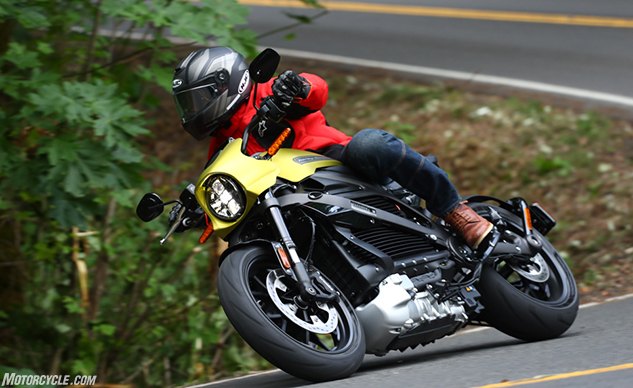
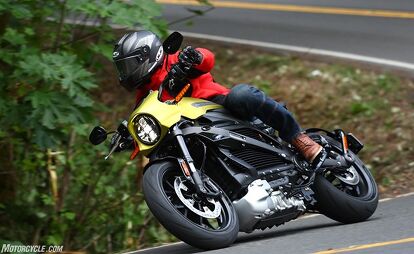














































































































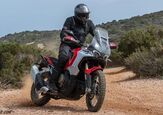

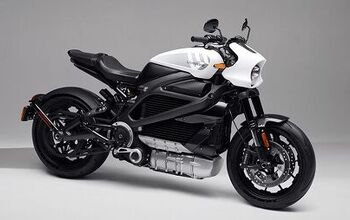

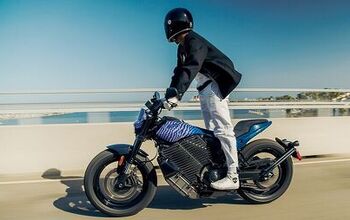

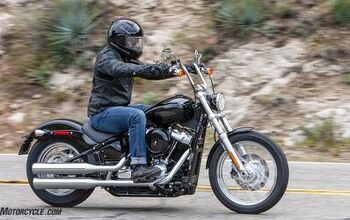












Comments
Join the conversation
Make it in a touring/bagger style, throw in a reverse gear, and I'm in....Can't wait to slide up alongside a Prius and rev. the motor....er...beep the horn!
"...there’s a high population of EV owners in this area..." I've always suspected this of Portlandians. Why else would they buy tertiary energy users? :D